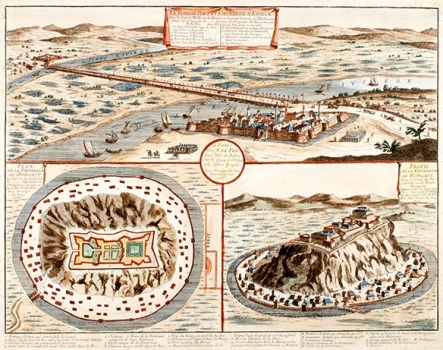DE FER, NICOLAS: OSIJEK BRIDGE AND MONGAČ FORTRESS
The upper half of the view (18x50 cm) shows the famous Osijek Bridge, which was built by Suleiman the Magnificent in 1566, when he was preparing to conquer Vienna. Because of its technical characteristics and strategic importance, the bridge has become famous throughout Europe. There are several different descriptions and numerous views, most of which were imagined. De Fer's view of the bridge corresponds to the proven facts that the bridge consisted of 3 segments, namely the access road from Osijek, the bridge across the Drava River, which was built on boats (the number of boats varies from 36 to 132), and the road on the pillars to Darda. The total length of the road was 8 km, the width in the descriptions varies between the width of two to four chariots. In any case, it was one of the largest construction projects in Europe, where thousands of people participated for two to three weeks. Thanks to the bridge, Osijek soon became the most important city of Turkish Slavonia and experienced strong economic development. The Suleiman Bridge was in focus again due to European interest in January 1664. With great effort, in a sudden penetration from Bobocsa, the bridge was burned by Croatian ban Nikola Zrinski. He was a great-grandson of Nikola Zrinski who halted Suleiman the Magnificent in Siget in 1566 on his way to conquer Vienna. Many contemporaries (Hieronymus Ortel, Etore Scala, Christopher Boethius, etc.) wrote about Zrinski’s feat and many views and leaflets were made. Due to its importance, the bridge was rebuilt in just three months in a new place, not far from the old bridge, so that in May 1664 the Turkish army penetrated across the bridge in southern Hungary. Twenty years later, in 1685, Count Jacob Lesle, who led an Austrian army of 30,000 people, penetrated Virovitica and came to Osijek. There he ordered all tallow, hall, fat, oil and resin to be collected and by smearing the bridge, he burned it off from the Osijek side. In the next few hours, the bridge was destroyed in a length of 1,100 steps. The news of the burning of the bridge for the third time spread to Europe again and resulted in a series of descriptions and drawings. De Fero's drawing emerged on that occasion. It depicts the status just before the Austrian army's penetration. On the impressive view, on can see the fortified city of Osijek and the bridge that corresponds to the descriptions of the original bridge. The remains of the bridge that was partially burned by Nikola Zrinski can no longer be seen.

